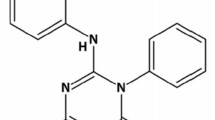Summary
The pharmacokinetics of lisuride hydrogen maleate (LHM) were investigated in rat, rabbit and rhesus monkey. Experiments were designed to meet not only the requirements of drug registration but also to serve other preclinical disciplines (toxicology, pharmacology).
LHM is absorbed almost completely at a dose level of 100–250 μg/kg. During absorption and first liver passage (FPE) LHM is metabolized. The FPE was highest in the rhesus monkey and lowest in the rat. Calculated on bioavailability during chronic tolerance studies, in the highest dose group rats were burdened with 180-fold and rhesus monkeys with 70-fold the highest human dose (parkinsonism). Total clearance values indicated the presence of extrahepatic metabolism in all animal species. Terminal half-lives of unchanged drug in plasma were in the range of a few hours. Therefore, no accumulation of unchanged drug was expected to occur following daily repeated administration in the animal species investigated.
Elimination of14C-radioactivity proceeded mainly via the liver in rat and rabbit. The rhesus monkey excreted most of the dose administered in the urine. Enterohepatic circulation of l 4C-material was demonstrated in the rat. In the, rat but not in the other two species a small part of the dose (about 2%) accumulated in blood cells in the form of metabolites.
Unchanged lisuride is able to cross membranes very rapidly, this was shown in distribution studies (whole-body autoradiography of rat, direct measurements in rat and rabbit). Transfer of lisuride into fetuses and brain is governed by its concentration in plasma. Drug level decrease in fetuses and brain was shown to be somewhat slower than in plasma. Detailed evaluation of the distribution pattern in the brain of rat and rabbit showed a high affinity of lisuride for its preferential target tissue, the pituitary.
Similar content being viewed by others
References
Kehr W., Speckenbach W. (1978): Effect of Lisuride and LSD on Monoamine Synthesis after Axotomy or Reserpine Treatment in Rat Brain, Naunyn-Schmiedeberg’s Archive Pharmacol,301, 163–169.
Keller H.H., Da Prada M. (1979): Central Dopamine Agonistic Activity and Microsomal Biotransformation of Lisuride, Lergotrile and Bromocriptine, Life Sciences,24, 1211–1222.
Horowski R., Wachtel H. (1976): Direct Dopaminergic Action of Lisuride Hydrogen Maleate, an Ergot Derivative, in Mice, Europ J Pharmacol,36, 373.
Horowski R., Wendt H., Graf K.-J. (1978): Prolactin-Lowering Effect of Low Doses of Lisuride in Man, Acta Endocr.,87, 234–240.
Hardt W., Schmidt-Gollwitzer M., Horowski R. (1979): Suppression of Lactation with Lisuride, Gynaecol Obstet Invest10, 95–105.
Bohnet H.G., Hanker J.P., Horowski R., Wickings E.J., Schneider, H.P.G. (1979): Suppression of Prolactin Secretion by Lisuride throughout the Menstrual Cycle and in Hyperprolactinemic Menstrual Disorders, Acta Endocr,92, 8–19.
Liuzzi A., Chiodini P.G., Oppizzi G., Botalla L., Verde G., De Stefano L., Colussi G., Gräf K.J., Horowski R. (1978): Lisuride Hydrogen Maleate: Evidence for a Long Lasting Dopaminergic Activity in Humans, J Clin Endocrinol Metab,46, 196–202.
Liuzzi A., Chiodini P., Verde G.I., Cozzi R., Botalla L., Rainer E., Horowski, R. (1980): Effectiveness of the Dopamine Agonist Lisuride in the Treatment of Acromegaly and Pathological Hyperprolactinemic States, J Endocr Invest4, 405–414.
Hümpel M., Nieuweboer B., Wendt H., Hasan S.H. (1981): Radioimmunoassay of Plasma Lisuride in Man Following Intravenous and Oral Administration of Lisuride Hydrogen Maleate; Effect on Plasma Prolactin Level Eur J. Clin Pharmacol20: 47–51.
Speck U., Wendt H., Schulze P.E., Jentsch D. (1976): Bioavailability and Pharmacokinetics of Cyproteroneacetate-14C and Ethinylestradiol-13H after Oral Administration as Coated Tablet (SH B 209 AB), Contraception,14, 151–163.
Ullberg S. (1954): Studies on Distribution and Fate of35S-labelled Benzylpenicillins in Body, Acta Radiol,118.
Own unpublished results.
In: Bourne G.H. (Edt.): The Rhesus Monkey, Vol.1, 22, 52, Academic Press N.Y., S. Francisco, London (1975).
In: Altman P.L., Dittmer D.S. (Edts): Biology Data Book 2nd Edition, VolIII, 1705 (1974), Federation of American Societies for Experimental Biology, Bethesda. Maryland
Toda T., Oshino N. (1981): Biotransformation of Lisuride in the Hemoglobin — Free Resfused Rat Liver and in the Whole Animal. Drug Metab. Dispos, 9, 108–113.
Author information
Authors and Affiliations
Rights and permissions
About this article
Cite this article
Humpel, M., Toda, T., Oshino, N. et al. The pharmacokinetics of lisuride hydrogen maleate in rat, rabbit and rhesus monkey. European Journal of Drug Metabolism and Pharmacokinetics 6, 207–219 (1981). https://doi.org/10.1007/BF03189490
Received:
Issue Date:
DOI: https://doi.org/10.1007/BF03189490



